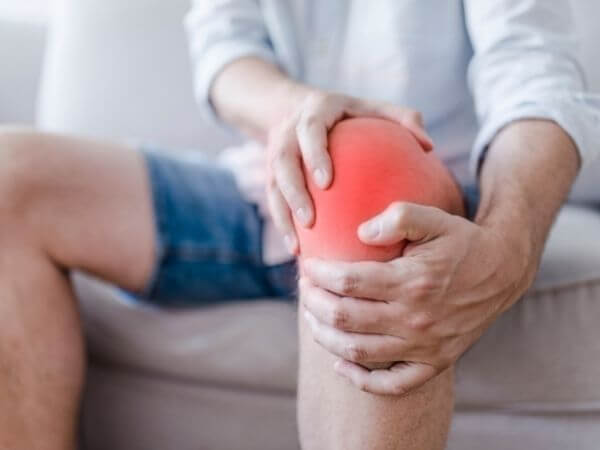Your knee pain can have many causes. Some people have arthritis, others suffer from sprains, and others experience knee pain caused by overuse injuries.
So, first things first:
You have to see a doctor to receive a correct diagnosis and treatment plan, which will likely include medicine and/or physical therapy.
That means, before getting on your elliptical trainer, you need your doctor to give you clearance. With that in mind, let’s see if that elliptical is suitable for your bad knees.
Table of Contents
Can Elliptical Damage Knees?
Elliptical machines are low-impact, and science tells us that low-impact exercises are less damaging to the joints. That means your elliptical shouldn’t give you any pain in the knee area if you’re using it right.
However, getting that diagnosis from your doctor is crucial because not all knee pain is created equal.
For example, people with arthritis can thrive on ellipticals. In fact, this type of exercise can genuinely alleviate their aches.
By contrast, someone with a tear or overuse injury can feel increased pain on an elliptical.
Does Elliptical Strengthen Knees?

Elliptical machines are proven to strengthen knees in people with arthritis thanks to:
- Increased blood flow in the knee cartilage area
- Stronger nearby muscle groups
Therefore, instead of increasing pressure on your knees, the elliptical machine takes that force and puts it on the glutes. Besides the glutes, you’re also going to use your quads and hamstrings quite a lot when you’re on that elliptical.
Strengthening those muscle groups reduces knee pain in the long term because you’ll have better muscle/joint alignment. As a result, you’ll keep a correct posture during your daily activities and, thus, put less pressure on your knees.
There’s more, though:
Exercising on an elliptical can speed up your post-injury recovery. The reason is that elliptical workouts are low-impact, so they prevent further stress fractures or tears.
Of course, you’ll need to get that go-ahead from your doctor/physical therapist. And, if you notice any pain during your workout, be sure to stop immediately.
How to Protect Knees on Elliptical?
The first and best way to protect your knees during your elliptical workout is to not exercise in the first place without your doctor’s approval.
After that’s sorted, you have to keep a correct posture, so be mindful of your:
- Hand position
- Foot placement on the pedals
- Incline
Adjust all these factors according to your body shape and height, and never push through any pain.
Related: 7 Best Exercise Machines Easy on Your Joints
Elliptical Vs. Bike

Remember that your knees absorb two times your body weight during walking, running, or climbing stairs. So, if you want to minimize knee pain or reduce shocks to your knees, you’ll want to choose a low-impact machine.
Both ellipticals and stationary bikes are great for the job, but ellipticals offer a more weight-bearing exercise.
And we can’t tell you if that’s good or not for you.
That depends on the type of pain you’re experiencing, whether post-injury or not, and your current fitness level. Therefore, only your doctor or PT can recommend a personalized exercise regimen.
But:
Weight-bearing exercises are not the devil, even if you already have knee pain. These exercises strengthen your bones, and you need stronger bones to recover or reduce the chance of future injury.
That said, if you have severe joint pain, the chances are that your doctor will recommend working out on an upright/recumbent bike.
Elliptical Vs. Treadmill
Elliptical machines put less stress on your joints, including your knees than treadmills. The reduced impact and less stabilization required means that your knees absorb less force.
That’s great if you have knee pain, are recovering from injury, or have frail bones because:
- Keeping your feet secured on the pedals means you won’t twist your ankles or knees.
- Working out on an elliptical improves your overall balance.
Besides, elliptical workouts are still challenging, particularly if you increase the resistance. As a result, you can quickly progress and strengthen your muscles/joints in the long run.
On the other hand, treadmills are suitable for your knees, too, because weight-bearing exercises strengthen bones. However, you shouldn’t overdo anything:
- Ask your doctor’s opinion before choosing your workouts.
- If you already have knee pain, consider an elliptical first or avoid running on the treadmill.
- Stop immediately if you feel pain.
Related: Treadmill Vs. Elliptical Vs. Bike: Factors To Consider
Treadmill vs Elliptical for Weight Loss – Which is better?
In Conclusion. Is An Elliptical Good or Bad for Knees?
Elliptical machines are generally good for knees because they improve mobility and strengthen your cartilages and surrounding muscle groups.
Ellipticals are arguably better at this job than stationary bikes and treadmills because they offer the best of both worlds: reduced impact and weight-bearing exercise.
However, you have to choose a highly-adjustable elliptical machine that ensures you’re keeping a correct posture on it. Also, remember to ask for your doctor’s advice first and never push through the pain.
- 7 Exercises for Pregnant Women in the First Trimester: Safe and Effective - January 30, 2025
- Our equipment recommendations - October 30, 2024
- Here’s What Doing Cardio Every Day Does To Your Body - August 21, 2024

